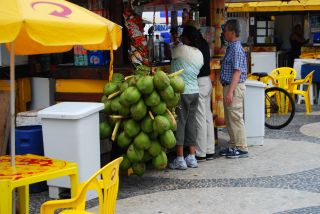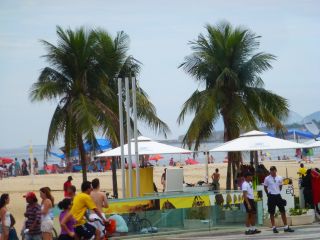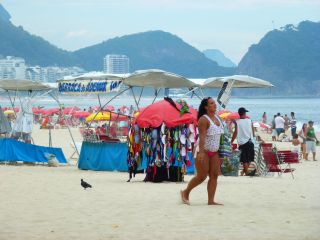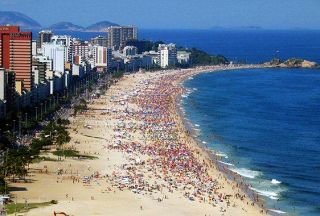 |
 |
 |
 |
 |
 |
 |
 |
 |
Etymology
The word "Ipanema" comes from the Tupi language and means "stinky lake", from upaba ("lake") and nem ("stinky").
History
Most of the land that Ipanema consists of today once belonged to José Antonio Moreira Filho, Baron of Ipanema. The word "Ipanema" did not refer originally to the beach, but to the homeland of the baron at São Paulo. Ipanema gained fame with the start of the bossa nova sound, when its residents Antônio Carlos Jobim and Vinicius de Moraes created their ode to their neighborhood, "Girl from Ipanema." The song was written in 1962, with music by Jobim and Portuguese lyrics by de Moraes with English lyrics written later by Norman Gimbel. Its popularity has seen a resurgence with 's song "Boy from Ipanema" released in 2008.
Character
Ipanema is adjacent to Copacabana Beach, but it is distinct from its neighbor. It is relatively easy to navigate because the streets are aligned in a grid. Private infrastructure has created world-class restaurants, shops, and cafes. Ipanema is one of the most expensive places to live in Rio. At the forefront of the beach culture are the many surfers and sun worshippers who socialize daily at the beach. Every Sunday, the roadway closest to the beach is closed to motor vehicles and local residents and tourists use the opportunity to ride bikes, roller skate, skateboard, and walk along the ocean.
Ipanema has played its own role in Rio's culture since its beginning. It has universities, art galleries, theaters and cafes. Ipanema holds its own street parade during Carnival festivities, separate from Rio de Janeiro's. Banda de Ipanema attracts up to 50,000 people to the streets of Ipanema for Carnival.
Beach
It is famously known for its elegance and social qualities. Two mountains called the Dois Irmãos (Two Brothers) rise at the western end of the beach. The beach is divided into segments by marks known as postos (lifeguard towers). Beer is sold everywhere on the beach along with the traditional cachaça. There are always circles of people playing football, volleyball, and footvolley, a locally invented sport that is a combination of volleyball and football.
In the winter the surf can reach nine feet. The water quality varies with days of light-blue water to a more murky green after heavy rains. Constant swells keep the water clean. The often treacherous beach break regularly forms barrels. Just west of this colorful section and towards Leblon is another popular stretch of sand known as Posto 10 (10th lifeguard tower) where young and often beautiful carioca men and women hipsters congregate. The Travel Channel listed Ipanema Beach as the sexiest beach in the world.
Posto 9
Posto 9's tradition began around 1980 when the present deputy Fernando Gabeira, came back from his political exile in France and was photographed there in a thong. He had been a political terrorist who, with his MR-8 mates, kidnapped the American ambassador in the sixties to release some political prisoners in Brazil, that was under a dictatorship at that time. In the eighties he became a political celebrity and his picture appeared on the front pages of all Brazilian newspapers together with his declarations that he was bisexual. His going to the beach at that spot made it famous throughout the country.
It inherited the status of a "cool and alternative" space in Ipanema beach from the area next to a pier that was demolished in the seventies, near Farme de Amoedo Street. It has a long history of pot smoking (illegal in Brazil), police raids, and left-wing, as well as alternative, gatherings.
Safety
Ipanema is generally regarded as one of the safest districts in Zona Sul. It is a mostly middle to upper middle class neighborhood being the second most affluent neighborhood in Rio after Leblon, which has communities of large residential homes. As such, it is usually patrolled by more police than other areas of the city.
